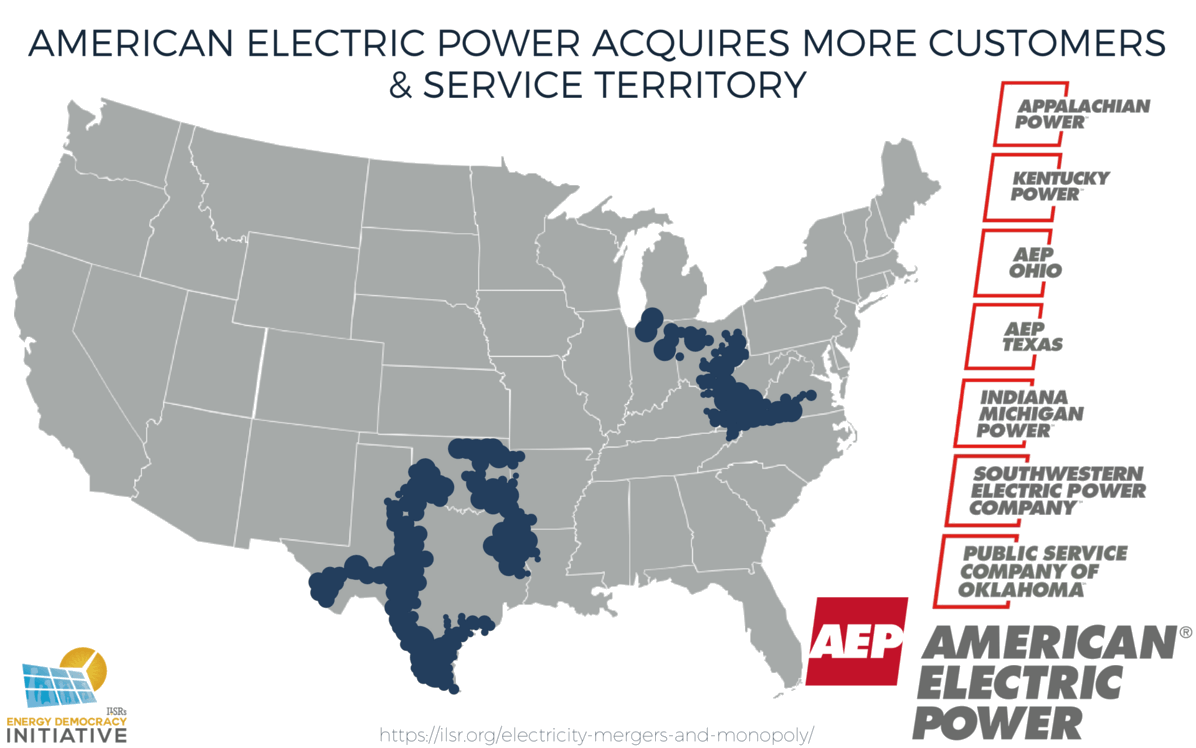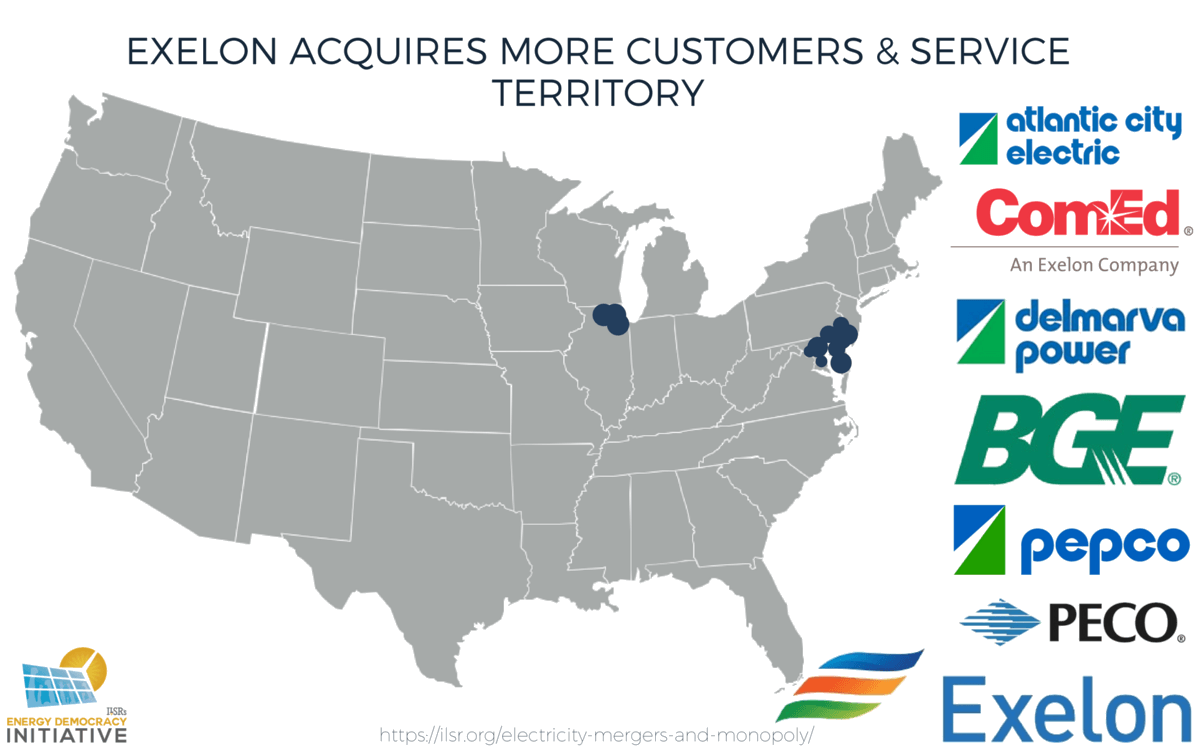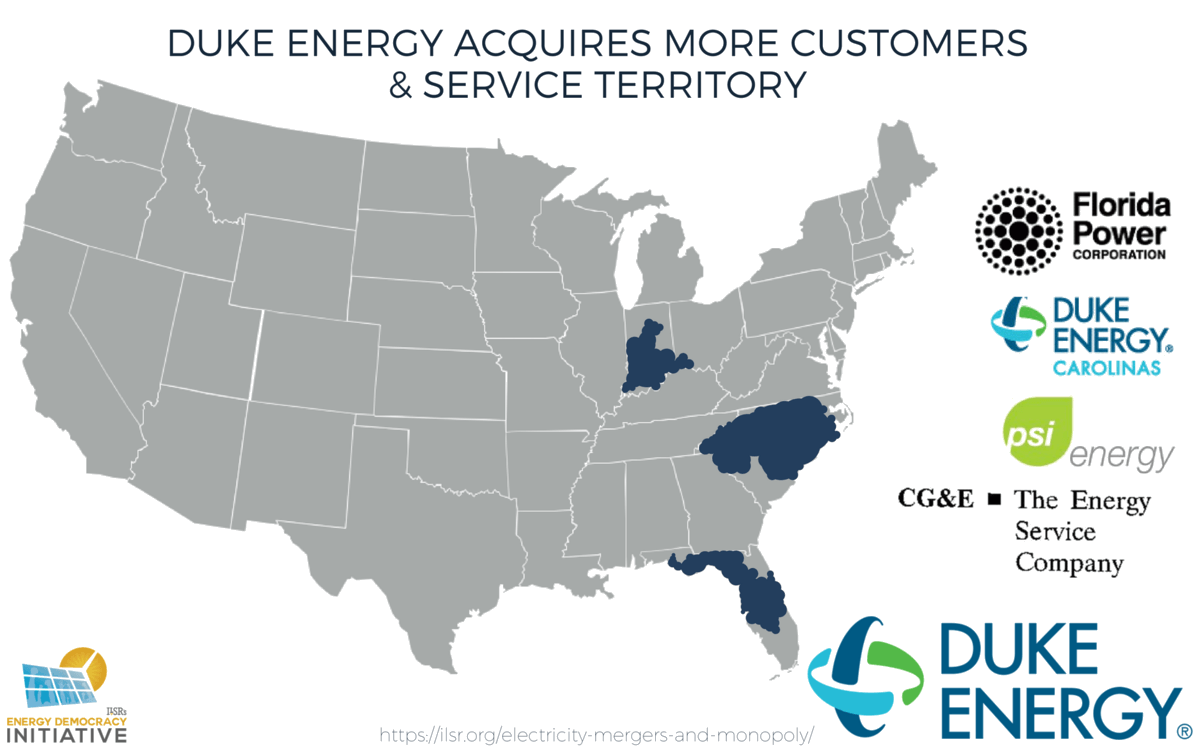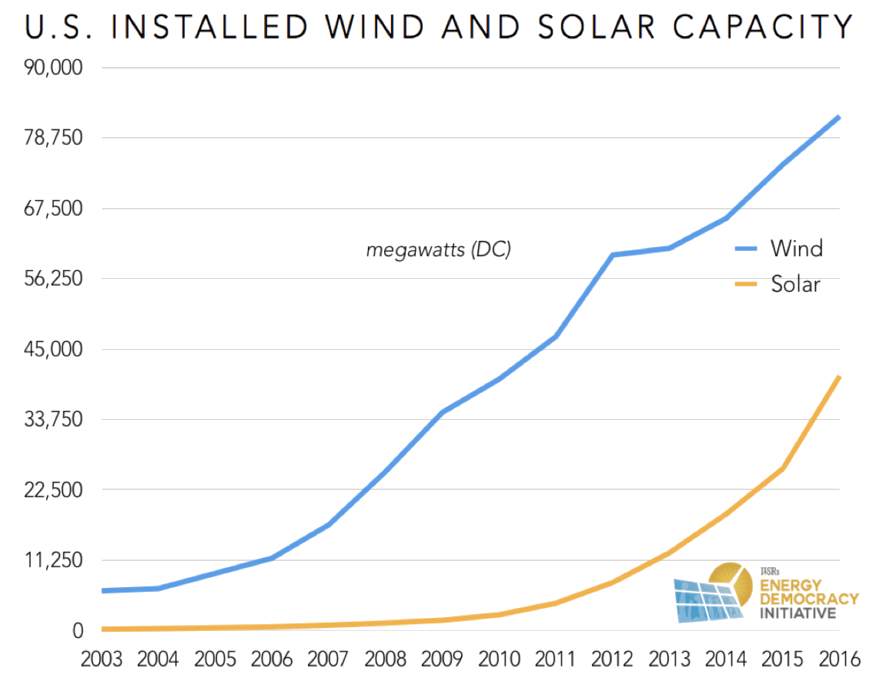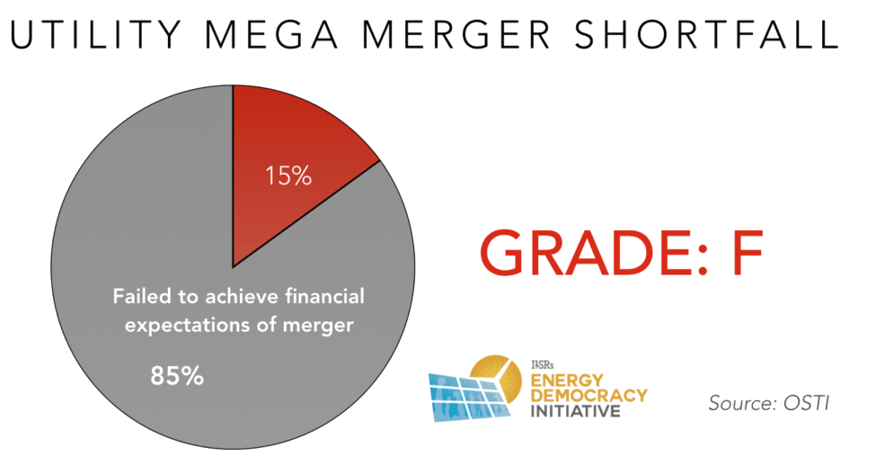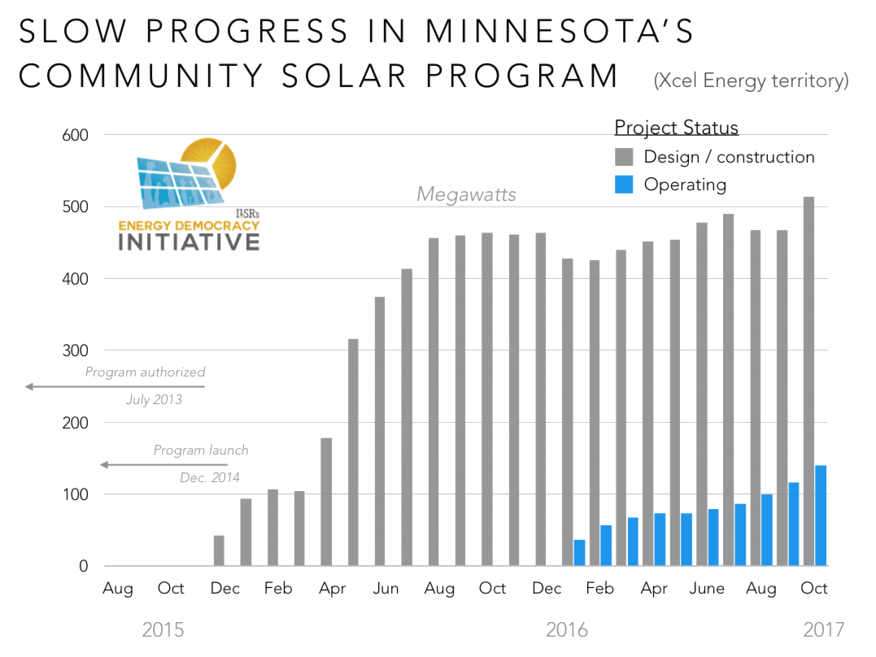Report: Mergers & Monopoly: How Concentration Changes The Electricity Business
Support CleanTechnica's work through a Substack subscription or on Stripe.
In the Fall of 2017, the Institute for Local Self-Reliance released a report detailing the impact that monopoly electric utilities have on the political economy of states and regulators.
Executive Summary
A wave of consolidation has swept across the U.S. economy over the past decade, reshaping already-powerful corporations into financial and political powerhouses. The trend has taken particular hold among electric utilities, a sector where monopoly reigns virtually unchecked.
Consolidated, investor-owned utilities now have service territories that span several states and include millions of customers. They say gobbling competitors delivers operational efficiencies and cost savings. But who sees the benefits? And what are the unspoken costs?
This report explains how concentration of power in monopoly utilities delivers fewer customer benefits than alleged, and how the unmentioned costs of concentrating power in a few firms undermines protection of the public interest.
The House Always Wins
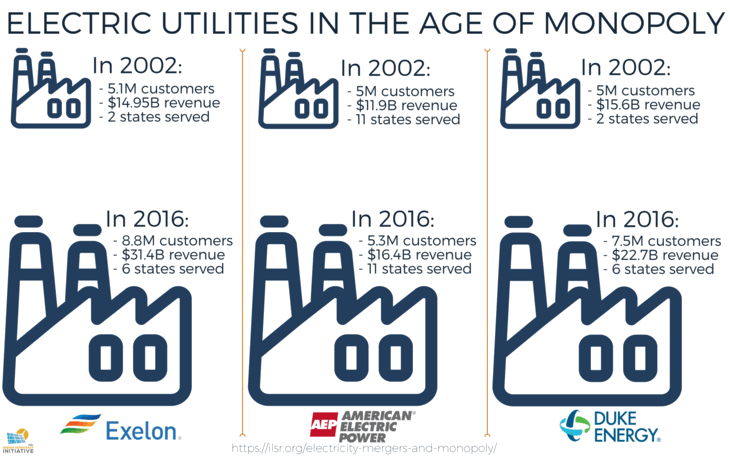
Despite efforts to cast consolidation as customer-friendly, the benefits are heavily weighted in favor of utility shareholders.
Unequal Financial Benefits
Most utility mergers feature large benefits for company shareholders, but much smaller benefits for customers. When Exelon, the nation’s largest nuclear power generator, unveiled in 2014 its plan to swallow Washington, D.C.-based utility Pepco in a $6.8 billion deal, it pledged $100 million toward a fund earmarked for rate credits, low-income assistance, and energy efficiency across its multi-state territory. That translates to just $50 per customer, compared with the whopping $1.1 billion that the merger unlocked for Pepco shareholders.
Unspoken Costs to Competition
As they grow larger through consolidation, utilities use their size as cover from competitive markets. Mergers help preserve monopoly utilities’ market share, even amid a dramatic shift in how Americans can generate, consume, and engage with our energy.
For example, the cost of large-scale renewable energy projects are so low today that utilities’ legacy fossil fuel power plants can’t compete on price. Customers seeking distributed energy resources, including rooftop solar and energy efficiency, threaten to choke off an ever-larger portion of the traditional utility revenue stream.
Few utilities are adopting a new business model. Instead, facing an existential crisis, many turn to consolidation to extend the life of last century’s business model. This approach may deliver near-term gains for utility investors, but it leaves captive customers to with rate increases, reduced choice, and ongoing financial risk as well as a strong incentive to seek non-utility alternatives like solar and storage.
Unfair Influence
As investor-owned utilities grow larger, so does their influence in government, in the regulatory process, and in the marketplace. Increasingly, this translates to outflanking rules and regulations meant to safeguard consumers and promote cost-effective electricity service.
LOBBYING POWER
Multi-state utility conglomerates have economies of lobbying, able to replicate their experience beating back competition in one state’s regulatory scheme in others states, as well. Earlier in 2017, Minnesota’s largest investor-owned utility, Xcel Energy, used its 50 lobbyists at the State Capitol to pass legislation that allowed it to bypass necessary regulatory review of a new gas plant — a project that could end up costing its customers billions of dollars. Florida’s investor-owned utilities employ one lobbyist for every two legislators, and they recently sunk more than $25 million into a failed ballot initiative to significantly constrain solar development.
TRADE GROUP POWER
Utility trade groups also have substantial influence, driven by utility executives. These coalitions, such as the Edison Electric Institute, spearhead efforts to limit adoption of distributed solar and other tools for customers to cut their electricity bills. In a brutal twist, utilities’ multimillion-dollar membership dues to these associations are subsidized by customers.
MARKET POWER
Working inside and outside the regulatory system, utilities can set onerous processes and standards for customer-friendly options, like distributed solar. They can also tack on fees that dampen the financial feasibility of such projects. These tactics succeed when utilities have no meaningful competition and when their public regulators fail to curtail their financially selfish behavior. Minnesota’s Community Solar program, discussed in greater detail in the report, is an example where utility stalling tactics resulting in a multiyear delay in getting projects operational.
Limited Public Oversight
Despite a stark imbalance in benefits for customers versus shareholders, mergers face limited scrutiny from public regulatory bodies. The Exelon-Pepco union represents one of the largest and highest-profile deals in recent years.
Exelon’s core business going into the deal was a fleet of increasingly obsolete nuclear power plants that face competition in numerous state wholesale electricity markets. When those plants can no longer earn enough revenue to cover their costs, it will look to Pepco (and its customers) to plug any gaps. In fact, Exelon’s operating income since 2011 has fallen short of the industry average, an ominous sign for the customers it claimed through its Pepco takeover. Dozens of other transactions have followed a similar roadmap.
Solution: Ensure Mergers Support Public Interest
While the regulatory process has done relatively little to slow the flow of utility mergers, some states have more acutely centered the public interest in their analysis. Massachusetts in 2011 changed its rubric to evaluate whether a proposed deal would deliver substantial benefits rather than merely avoid harming customers.
When jurisdictions like Massachusetts (along with Pennsylvania and Washington, D.C.) treat “public interest” as a synonym for “customer benefit,” regulators have more leeway to probe — and deny — transactions.
Texas regulators considered similar criteria earlier this year, when energy conglomerate Hunt Consolidated offered to purchase Oncor, Texas’ largest utility, for more than $17 billion. The deal floundered under the weight of regulatory skepticism, in part over a complex plan that would have restructured Oncor to generate a $250 million tax break. Hunt’s plan spelled out benefits for investors, but state officials balked at a lack of commitment to pass value on to customers.
It remains unclear and variable exactly how much customer benefit is enough to clear the regulatory hurdle, especially in states with looser interpretations of the public interest concept.
A singular fact looms large over any proposed merger — utilities have a fiduciary duty to maximize value for their shareholders, placing their investors squarely at the center of every business decision. Until regulators proactively counter this bottom-line motivation with their responsibility to the public interest, utility customers will come second, and remain captive to utilities with an antiquated business model in a modern world of distributed power.
Full Report
A wave of deal-making over the past two decades has fundamentally reshaped the competitive landscape for U.S. electric utilities, part of a rising tide of consolidation in American business.
In 2015, U.S. deal-makers inked a record number of mergers across a range of sectors. And while 2016 got off to a sluggish start, U.S. companies made October the busiest-ever month. In an end-of-year survey of 1,000 corporate bigwigs and investment pros, 86% said they expected greater more mergers in the year ahead while more than 60% predicted heftier dollar values.
As in other industries, merger proponents in the electric utility sector tout higher efficiency and cost savings to defend their deals. But evidence suggests the potential savings for customers are questionable. Rather than being a boon to utility customers, merger benefits accrue primarily to investors.
Furthermore, as the industry shifts power into the hands of fewer players, it’s decreasing customer choice — even as evolving energy technology, from smartphones to batteries to solar, ought to enable more local choices.

Electricity is an essential service and a big business. More than 99% of homes have electricity, used for lighting, heating and cooling, refrigeration, and powering ubiquitous electronic devices from TVs to smartphones. Electric utilities sell more than $360 billion worth of electricity each year to American consumers, businesses, and industry.
Originally, electricity generation was more of a local affair, with power plants serving city neighborhoods. As the industry matured in the early 20th century, power plants grew larger and so did utility companies, to a degree. Even as recently as two decades ago, most utilities served a city or a region within a single state. The limited scope of utility companies aligned with public oversight. Legislatures across the country signed compacts with utilities: many for-profit utilities were given monopolies over their service territory in exchange for public oversight via state regulators.
These monopolies persist today: some utilities own everything from the power plants and lines down to the meters on customers’ homes, others have a monopoly just over the poles and wires that deliver power the “last mile” to customers. These monopoly “investor-owned” utility companies sold (and still sell) about three-fourths of the electricity produced in the U.S. City-owned “municipal” utilities and electric cooperatives sell the remainder.
Already larger than their not-for-profit counterparts, investor-owned utilities are joining the economy-wide trend of going big. Once limited to a single state, massive multi-state utility holding companies now include more than a dozen subsidiaries. This cross-state consolidation is allowing utilities to skirt public interest oversight, oversight that was central to the 20th century compact allowing these private companies to operate without competition.

Charged with providing a crucial public service, electric utility mergers deserve stricter scrutiny and more pointed questioning than regulators have provided. A critical question remains unaddressed: with the rise of solar energy, battery storage, and electric vehicles, do monopoly companies — merged or not — make sense in an electricity system that is becoming so decentralized?
Utility Merger Mania
Over the past decade, utility consolidation has reached an unprecedented pace. American Electric Power, based in Ohio, illustrates the trend.
The holding company serves 5 million customers across the U.S. after acquiring a series of smaller power providers. Its collection of subsidiaries includes Appalachian Power, AES Ohio (itself formed through a 2011 merger between Columbus Southern Power and Ohio Power), Indiana Michigan Power, Kentucky Power, and Wheeling Power. The company also joined with another holding company, Central & South West Corporation, in a deal that brought three more subsidiaries — PSC of Oklahoma, Southwestern Electric Power, and West Texas Utilities — under its umbrella.
AEP’s complex network of power providers is just one of the jam-packed portfolios becoming increasingly common across the sector.
Perhaps the most notorious recent example of utility consolidation came in 2014, when Exelon, the nation’s largest nuclear power generator, lobbed a $6.8 billion takeover bid at Pepco, a utility based in Washington, D.C. The deal — which closed last year after extensive regulatory review and a near-death experience before the D.C. Commission — expanded Exelon’s growing portfolio. Along with previously acquired ComEd in Illinois and Baltimore Gas & Electric, it formed the largest utility in the country, with more than 8 million customers.
The next-largest utility holding company, Duke Energy, serves more than 7 million customers — a figure that rose after its 2012 merger with Progress Energy.
Shaky Rationale
The trend toward consolidation of utility companies runs counter to a technological trend toward decentralized grid resources. Rooftop solar, battery storage, and electric vehicles are all growing more enticing to consumers as their prices drop. Solar energy capacity has been growing exponentially, reaching over 40 gigawatts by the end of 2016. Combined with wind power, the two renewable technologies now provide 10% of U.S. electricity supply, but range as high as 37% wind in Iowa and 35% solar in Hawaii.
Energy storage has entered the market, with opportunities for utility customers to add battery backup power in their homes for just $15 per month and to buy less energy from the utility than ever before. Hundreds of thousands of businesses can already buy batteries to cut their electric bills by using on-site storage to reduce their periods of highest energy use.
Electric vehicle sales are growing, with an expected surge as they become cheaper to own than gas-powered cars. Today’s electric cars already have a battery large enough to cover the daily travel needs of 4 in 5 Americans or, alternatively, to power the average American home for 24 hours.
The widespread dispersion of smartphones is giving electric customers unprecedented power to control their electricity use, from WiFi-enabled thermostats to apps for controlling car charging.
Even ignoring how technology is undermining centralization and consolidation, utility mergers have major flaws.
Most mergers are justified on shaky grounds of “synergies” and cost savings. Exelon, for example, touted more than $250 million in expected net synergies over the first five years of its union with Pepco, but offered little guidance on what exactly that means for itself, its investors, or — most importantly — for customers.
In fact, big-ticket transactions have a comically lopsided payoff. When it unveiled its Pepco acquisition plan, Exelon said it would put $100 million into a “Customer Investment Fund” to cover rate credits, assistance for low-income customers, and energy efficiency improvements across its target’s multi-state service territory. That shakes out to a paltry $50 per customer, a sharp contrast to the $1.1 billion payday for Pepco shareholders.
Similarly, an ill-fated $4.3 billion proposal to unite NextEra Energy and Hawaiian Electric — a rare casualty of a rigorous regulatory review — promised Hawaiian Electric shareholders a $568 million purchase premium, far outpacing the $60 million conditional payout set aside for customers (who, incidentally, pay the highest electricity rates in the nation).
In a damning analysis around the turn of the millennium, during another wave of utility merger activity, META Group concluded that utility executives often overestimated both the long-term value of their deals and their own capability to parlay mergers into tangible, positive results.
Utilities are, historically speaking, not nimble organizations. For decades, success for utilities was defined by consistent and predictable performance… Deregulation and the associated increase in competition requires a different set of competencies, namely the definition and implementation of change initiatives. Successful change requires realistic and rigorous assessment and planning. Survey results suggest that few utilities perform the necessary assessment and planning steps critical to the success of mergers and acquisitions. (emphasis added)
An Act of Desperation?
Many utilities seek mergers to shield themselves from competitive pressures. Companies like Exelon jumped into competitive markets 25 years ago to grab bigger returns than state regulators offered utilities serving captive customers. Now, facing pressure to shore up revenue devastated by sluggish sales and lower cost distributed renewable energy, utilities are trying to turn back the clock.
Exelon, for example, has seen its aging fleet of nuclear power plants hammered by inexpensive wind power in competitive markets. In response, the company has taken over traditional monopoly distribution utilities to obtain the insurance of captive customers, ignoring the bottom-up pressure of distributed solar, storage, and smart appliances that are giving customers many more choices than they had in the past.
The “diversification” push of utilities like Exelon may offer returns-hungry investors relief, but it imposes added risk on captive customers, who must rely on regulators to shield them from losses their utilities accrue in competitive markets. The mergers also further narrow competition in an industry already grappling with a distinct power imbalance after years of consolidation.
Broken Promises
Most utility mergers must withstand only narrow scrutiny of cost savings, ignoring the political or economic implications of consolidation. But even measuring against the shortened standard of cost savings, many fail.
A robust analysis published in 1999 that probed a wave of then-recent utility mergers concluded that a mere 15 percent of tie-ups achieved the pre-merger financial objectives and expectations. A 2006 evaluation of utility mergers spotlighted a similar pattern of incomplete financial analysis.
An examination of more than 75 utility-sector mergers between 1994 and 2003 — deals that involved a combined $300 billion in assets — tested promises made by merging utilities, namely that the transactions would improve efficiencies (theoretically to the benefit of both consumers and shareholders). The study revealed that target companies’ efficiency, which typically started out higher than that of their acquirers, tended to slide back to the baseline after merging.
There are several examples of utility promises falling short, leaving customers in the lurch.
When Exelon swallowed Constellation Energy Group, the parent company of Baltimore Gas & Electric in 2012, the utilities hailed their union as a savings-generator. Maryland regulators hinged the deal on a promise that the state’s customers would see savings, but in their order acknowledged concerns over how consolidation would ultimately affect the utility’s customers:
Exelon CEO John Rowe considers industry consolidation “inevitable,” and so it seems, do the rest of the industry and financial community. It is not obvious to us that tying our regulated utility companies to this business model will be good in the long run for ratepayers or regulated utilities. Having watched major financial institutions become “too big to fail,” we wonder too if further consolidation in the electricity sector could expose BGE to a wider range of unregulated business risks or bury BGE deeper down Exelon’s priority list if the company grows still bigger in the future. (emphasis added)
But, the regulators went on to say, the transaction fit within the broad contours of Maryland law. Even though they had reservations about the deal — including doubts that customers would benefit from expected operational cost savings — they didn’t have a solid legal basis to shut it down.
The deal closed. Then, in 2012, 2013, and 2014, the utility scored rate increases of $53 million, $34 million, and $22 million, respectively — all falling on customers who were promised smaller utility bills. The merger didn’t do Exelon shareholders much good, either, with share prices consistently below 2012 levels for each of the past five years.
A similar specter looms over the recent Exelon-Pepco mega-merger. To the extent that Exelon’s core business — a fleet of aging and increasingly obsolete nuclear power plants — butts up against unfavorable market conditions, it’s up to Pepco (and its customers) to compensate. Exelon’s operating income since 2011 has lagged behind the utility industry overall, hardly a promising prospect for its new Atlantic Coast customers.
Maryland regulators required “ring-fencing” measures to keep divisions between Exelon and Pepco for the first several years of their union, in theory insulating Pepco customers (and investors) from volatility elsewhere in Exelon’s business. But while state officials contended that was an adequate defense for Pepco customers, they also recognized Exelon entered into the merger “to diversify its financial reliance on volatile power market revenues from its generation business with the steady income stream from increased ownership of regulated distribution companies.” With that rationale underpinning the deal, Pepco customers remain vulnerable.
In fact, they may already be paying a price. Though the company insisted the move was not related to the tie-up, less than a month after completing the transaction, Pepco asked Maryland regulators to green-light a 10 percent across-the-board rate hike for most of the 560,000 customers it serves in Montgomery and Prince George’s counties. Separately, the company requested a post-merger rate increase of 5.25 percent for DC customers.
Delmarva Power, one Pepco subsidiary absorbed in the Exelon deal, provided two $50 rate credits to Maryland customers as part of the transaction, but then won a 7 percent rate hike that will eat up those savings in 10 months for the average residential customer.
And remember AEP, our Midwest utility monolith? In 2016, AEP trumpeted that in the previous half-decade it provided a total shareholder return of 101 percent, blowing past the 61 percent average for the S&P 500 Electric Utilities Index. In April 2017, AEP asked Ohio regulators to approve a rate increase that would pump up fixed charges on customers’ bills by nearly 120 percent over the next two years (increases that would remain indefinitely).
Intransigent Utilities
The electric business takeover frenzy comes amid significant disruption to the traditional utility business model. Costs for large-scale renewable energy have fallen so low that legacy fossil fuel power plants can’t compete on price. Distributed energy resources including rooftop solar and energy efficiency threaten to choke off a growing portion of the utility revenue stream. As they provide customers with a viable alternative to their utility, the widening availability and increasing value of rooftop solar, battery storage, and other distributed energy resources render the traditional utility monopoly system obsolete.
Most utilities have chosen to resist rather than embrace the technological and market changes. Unfortunately, growing consolidation provides greater political power and market muscle for their resistance.
Push Back in Politics
Much of this intransigence manifests in lawmaking — cash-flush utilities often staff dozens of lobbyists to influence state lawmaking. In Minnesota, the state’s largest electric company, Xcel Energy, has 50 lobbyists that recently helped the utility skip regulatory review of a new gas plant, which could end up costing ratepayers billions of dollars.
Florida, a state where investor-owned utilities employ one lobbyist for every two legislators, is also home to some of the most contentious — and expensive — battles to retain the status quo for utilities. Utility backers spent more than $25 million on a failed ballot initiative that would have dramatically restricted rooftop solar development in the Sunshine State, a measure disguised as a promoter of consumer choice.
In California, PG&E has repeatedly tried to leverage the state Legislature to retain monopoly control over the northern California electricity market. After California enabled community choice aggregation, a framework for communities to wrest control of their energy mix from utilities, PG&E spent tens of millions of dollars on lobbying efforts for legislation designed to complicate and quell participation, and ultimately kill these programs.
Trade Group Tirades
Utilities also have influence through their trade groups. Heavily influenced by utility executives, these coalitions often amplify the voices of industry bigwigs eager to shut down competitive new technologies that allow customers to cash in at their expense. Utility coalition campaigns against customer choice can be subsidized by unwitting utility customers.
For example, Edison Electric Institute, the trade organization that represents U.S. investor-owned utilities, launched a multiyear anti-solar push, a bid to preserve outdated business strategies favoring costly utility-financed infrastructure investments. As it turns out, the trade group’s budget for the campaign — $90 million, the highest in a decade – comes out of customer pockets.
On a widespread basis, utilities lump in annual association membership dues with general operating expenses, allowing them to cover the cost with money from customers. This trend persists despite attempts by advocates and even regulators to exclude customers from paying for this kind of political spending, which regularly puts the utility’s bottom line ahead of their interests.
Membership in these powerful political lobbies is expensive. Exelon alone paid more than $3.3 million in dues during the first half of 2016 to Edison Electric Institute, one of more than a half-dozen industry groups it belongs to. It paid a whopping $9.4 million in that same span to the Nuclear Energy Institute, another lobbying group.
Staff at the Missouri Public Service Commission in 2015 took aim at the practice of using customer money for these purposes, finding that customers could see some benefits from their utility’s involvement in the trade group, but that “[trade group] membership appears to primarily benefit the company and its shareholders.”
A similar dynamic happens with multistate energy holding companies. Sprawling entities like Exelon, American Electric Power, or Duke Energy have a presence in several states that gives them economies of lobbying. They have outsize roles in shaping policy and steering disputes in their favor, across multiple jurisdictions. Utilities of this size and scale have influence that outmuscles most advocacy groups fighting for a fairer marketplace, customers, and even the regulators responsible for utility oversight.
Machinations with Market Power
Utilities can also leverage their control over the power grid to stifle alternatives to their product. Pepco, for example, has control over a series of processes its customers need to work through if they want to buy into distributed generation. These levers include:
- A potentially onerous interconnection process controlled mainly by Pepco through the availability of information available on its website, the responsiveness of its customer service, and the speed and ease with which applications are processed. A recent study showed the slowest utility to provide interconnection pre-approval took 75 times longer than the fastest.
- Fees imposed on customers with distributed generations including through the rate design that informs the value of net metering credits. Though Pepco must ultimately secure regulatory approval for these charges, it leads the conversations with those authorities. In other states, utilities have won fee increases without providing evidence of increased costs.
- Oversight of and responsibility for new investments and integration of technology that would support greater penetration of distributed energy resources.
How much can utilities use their grid management responsibility to stall programs they dislike?
In Minnesota, Xcel Energy was required by 2013 legislation to launch a community solar program. After initial proposals that fell far short of statutory requirements and long delays, the program launched 18 months after being authorized, only to face unilateral utility action to curtail proposed projects. It took a further two years for any meaningful development to reach commercial operation.
Electric utilities face an existential crisis, and their unwillingness to adapt to a changing market motivates mergers that threaten innovation in the energy economy.
Protecting the Public Interest
Amid increased deal activity, at least one state stepped up its role in the utility merger approval process. State regulators are charged with evaluating all proposed tie-ups based on how they would affect the public interest, a sometimes-amorphous standard, but one that can be wielded to great effect.
Massachusetts in 2011 adjusted its approach to the “public interest review,” switching from evaluating whether a deal merely causes no harm to whether it would deliver substantial benefits. Before, a deal could win approval if it was projected to be equal to or slightly better than the status quo — theoretically, even $1 of customer benefit was enough to clear the threshold. Now, parties in a merger must show how their union will deliver positive benefits to ratepayers that offset the costs or risks of the transaction.
Massachusetts and other jurisdictions — including Pennsylvania and Washington, D.C. — interpret “public interest” as “ratepayer benefit,” giving advocates and customers more room to push for better terms, in turn providing regulators more cover to question or strike down transactions.
Where regulators do not fully align their review with the public interest, the looser standard can give companies an easy way out. While regulators often look for customer value in transaction terms, there is typically no rubric for how much is sufficient, encouraging a culture where utilities — like Exelon in its merger with Pepco, and NextEra in its scuttled Hawaiian Electric takeover — throw just enough money at customers to clear the arbitrary hurdle.
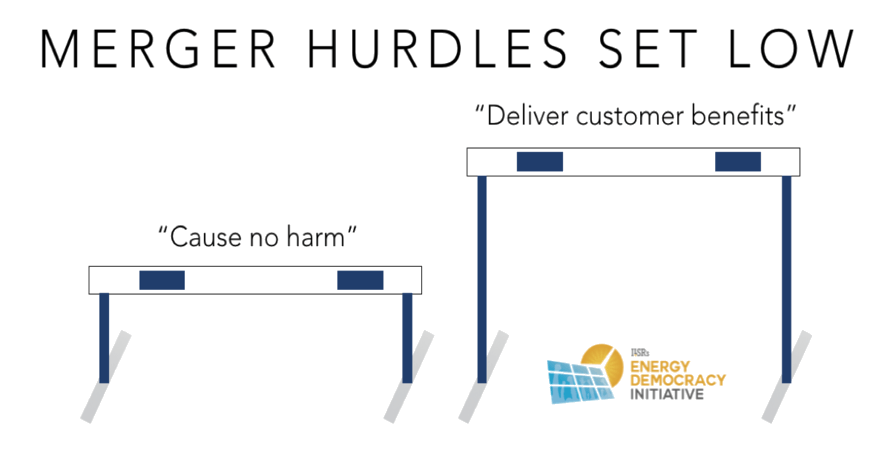 In addition, prospective merger partners frequently cite improved reliability and infrastructure as part of their reasoning. But regulators need to carefully scrutinize those plans; in many cases, these benefits could likely play out anyway, even if the utilities remained standalone companies.
In addition, prospective merger partners frequently cite improved reliability and infrastructure as part of their reasoning. But regulators need to carefully scrutinize those plans; in many cases, these benefits could likely play out anyway, even if the utilities remained standalone companies.
The Massachusetts standard puts utility customers closer to the center of these merger fights. It naturally sets a higher standard for prospective merger partners to prove why their union makes sense, while simultaneously leaving more room for advocate intervention and encouraging stricter scrutiny — all in service of utility customers.
Texas regulators considered similar criteria earlier this year, when energy conglomerate Hunt Consolidated offered to purchase Oncor, Texas’ largest utility, for more than $17 billion. The deal floundered under the weight of regulatory skepticism, in part over a complex plan that would have restructured Oncor to generate a $250 million tax break. Hunt’s plan spelled out benefits for investors, but state officials balked at a lack of commitment to pass value on to customers. Through the regulatory process, the company put its investors well ahead of customers. Pressed to distribute financial benefits of the transaction across both groups, an attorney representing Hunt told regulators, “we understand what you want, and we’ll try to sell it to our investors.” The proposed transaction fell apart less than two months later.
A more stringent public-benefit standard can empower regulators to ask for customer-friendly concessions from dealmakers reluctant to offer them upfront. These provisions could include rate freezes and credits to cost recovery requirements where investments are planned, as well as inclusive financing, for example.
While acquisition targets have a fiduciary obligation to maximize value for their shareholders, tighter regulatory constraints on deal-making can bring that interest into balance with fairness for utility customers. Following the blueprint of Massachusetts regulators, stricter state-level oversight could have a significant effect on filtering out problematic provisions in proposed mergers.
Raising the Monopoly Question
If customers can produce and store electricity more cost-effectively than utilities can deliver it, then the calculus of market structure changes. Instead of granting monopolies to concentrate capital in a few hands to build large-scale power plants, the market instead needs a way for customers to transact with one another. It needs a reliable infrastructure manager to oversee a platform where innovative individuals and companies can provide efficient electric service using 21st century technology.
The following graphic illustrates the technology-driven transformation in the electricity business, from a one-way, top-down to a multi-directional and decentralized system.
New York’s regulator-driven Reforming the Energy Vision project is calling this question, and is restructuring the rules to de-monopolize the electricity marketplace and allow many players to transact on a level playing field. Utilities are already responding to changed incentives by investing in new strategies from solar to storage to microgrids to meet electric customers’ needs, rather than pursuing financial engineering or mergers.
Mergers may extend the life of antiquated utility monopolies, but the regulators who decide whether to approve further consolidation should focus on the long-term stability of the electricity system. If neither utility partner has a viable business model for the electricity system of the future, then their ultimate failure will leave customers holding the bag.
This article originally posted at ilsr.org. For timely updates, follow John Farrell on Twitter or get the Democratic Energy weekly update.
Sign up for CleanTechnica's Weekly Substack for Zach and Scott's in-depth analyses and high level summaries, sign up for our daily newsletter, and follow us on Google News!
Have a tip for CleanTechnica? Want to advertise? Want to suggest a guest for our CleanTech Talk podcast? Contact us here.
Sign up for our daily newsletter for 15 new cleantech stories a day. Or sign up for our weekly one on top stories of the week if daily is too frequent.
CleanTechnica uses affiliate links. See our policy here.
CleanTechnica's Comment Policy

